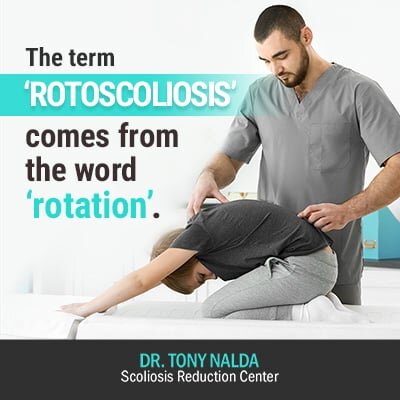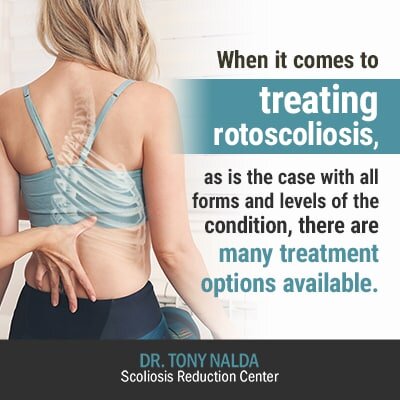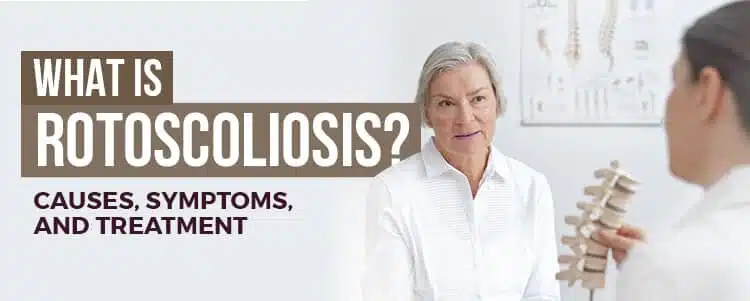Scoliosis is understood by most as a deformity that causes an abnormally curved spine, but there is a lot more that goes into classifying a condition. In order for scoliosis to be considered structural, and not just postural, in addition to a sideways bend to the spine, it also has to coincide with rotation; this is where rotoscoliosis comes in. The term ‘rotoscoliosis’ refers to cases of scoliosis where there is a significant amount of rotation, meaning the spine has a severe twist to it, in addition to the sideways bend.
When a person is first diagnosed with scoliosis, there are a lot of medical terms thrown at them that are sometimes hard to understand. This is an additional challenge to processing the news of having a life-long progressive condition. To lessen that challenge, let’s start by defining the term ‘rotoscoliosis’.
Breaking Down the Term: Rotoscoliosis
Scoliosis is defined as an abnormal sideways curvature of the spine. In order to be considered a true structural scoliosis, the curvature has to coincide with rotation, which means the spine bends and twists.

This is why scoliosis is considered a 3-dimensional condition and necessitates a treatment approach that addresses it as such.
The term ‘rotoscoliosis’ comes from the word ‘rotation’. While all forms of structural scoliosis have an element of rotation, if the term rotoscoliosis is applied, this means that there is a higher level of rotation and that the spine has a severe twist to it.
Due to the excessive rotational component in cases of rotoscoliosis, these are considered more complex spinal curvatures that are more likely to cause related symptoms and postural issues.
Symptoms of Rotoscoliosis
As there is more of a rotational component present in rotoscoliosis, the misalignment of the spine is more pronounced and tends to produce more noticeable symptoms throughout the body.
As scoliosis is a condition that can range from mild to moderate and severe, there are additional factors that determine a condition’s overall severity, such as the Cobb angle.
A patient’s Cobb angle is the orthopedic gold standard in scoliosis assessment. The Cobb angle is a measurement taken via X-ray that tells us just how far from a normal alignment a spine with scoliosis deviates.
The measurement is taken by drawing intersecting lines from the tops and bottoms of the most tilted vertebrae of the curvature. Once a patient’s Cobb angle is calculated, the condition is classified as either mild, moderate, or severe scoliosis:
Mild scoliosis – Cobb angle measurement of 25 degrees or less
Moderate scoliosis – Cobb angle measurement between 25 and 40 degrees
Severe scoliosis – Cobb angle measurement of 40+ degrees
If a patient’s Cobb angle is 10 degrees or higher and coincides with rotation, this is considered scoliosis. A scoliosis curvature can range from 10 degrees anywhere up to 150 degrees, so you can see how much a scoliotic curve can vary from one patient to another.
In addition to the degree of rotation and the Cobb angle, the patient’s rate of progression also plays a role in determining how they will experience the condition and related symptoms.
Visual symptoms associated with rotoscoliosis include:
- Uneven hips (one can sit higher than the other)
- Uneven shoulders (one sitting higher than the other)
- Shoulder blades that protrude more prominently
- An uneven waist
- A rib cage arch where one side of the rib cage protrudes more prominently than the other
- Arms and legs that appear to hang at different lengths
- Clothes that seem to hang unevenly and don’t fit properly
- Changes to gait
Causes of Rotoscoliosis
The causes of rotoscoliosis are the same as other levels of the condition, with the most common form being unknown. Adolescent idiopathic scoliosis (AIS) is the condition’s most common form and accounts for approximately 80 percent of diagnosed cases in the United States; this form is diagnosed between the ages of 10 and 18.
The other 20 percent have known causes such as neuromuscular, congenital, degenerative or traumatic.
In neuromuscular scoliosis, the scoliosis develops as a secondary complication of another medical issue such as cerebral palsy or muscular dystrophy. In these disorders, there is a disconnect in the communication between the brain and the muscles that support the spine.
In congenital scoliosis, the condition develops due to a malformed vertebra present at birth. In a healthy spine, its vertebrae are stacked on top of one another like rectangular-shaped bricks. When there is a congenital malformation, picture one of those vertebrae as triangular-shaped and you can imagine how that shift would cause a misalignment of the spine to develop.
Degenerative scoliosis affects individuals most commonly aged 40+. In this form of the condition, the discs of the spine are compromised and as they cushion the individual vertebra that make up the spine, when they are eroded, the spine slips out of alignment.
In traumatic scoliosis, as the name indicates, the spine has experienced an extreme trauma, such as a fall or car accident, that has compromised the spine.
Regardless of the form of scoliosis, the most important thing is to seek out active treatment as soon as possible. The earlier treatment is started, the more likely it is that a curvature reduction can be achieved.
Treatment for Rotoscoliosis

When it comes to treating rotoscoliosis, as is the case with all forms and levels of the condition, there are many treatment options available.
Here at the Scoliosis Reduction Center®, we have a variety of treatment disciplines available to our patients in one accessible location. We believe that the nature of scoliosis necessitates an integrative and customized approach, and we combine multiple forms of treatment to best address the individual characteristics of our patients and their condition.
We take X-rays from multiple angles so we can comprehensively gauge the patient’s Cobb angle, degree of rotation, and likely rate of progression. Once we have the information that these X-rays provide, we know all we need to design a customized treatment plan we feel will be the most effective and sustainable.
As a progressive condition, our treatment approach will include monitoring changes to the spine throughout treatment and tweaking the plan as we deem fit. The most common forms of treatment we use combine scoliosis-specific chiropractic, therapy, rehabilitation, and corrective bracing.
The above disciplines complement each other and work together to offer our patients the best possible prognosis. With more severe cases, the initial treatment can be intense, but as we start to see results, those efforts can be adjusted accordingly.
When I say “see results,” our main priority is to address the structural nature of the condition, so we work to manipulate the spine into a structural change; this means a reduction in the patient’s Cobb angle. As we achieve a curvature reduction, the spine’s overall biomechanics are improved, in addition to lessening any related symptoms the patient is experiencing.
Conclusion
There are many different types of spinal curvatures and just as many terms to describe them. A scoliotic curve can develop anywhere along the spine, can range from mild to severe, progress at wildly different rates, and have different degrees of rotation.
If the term ‘rotoscoliosis’ is applied, the degree of rotation is significant and becomes one of its defining characteristics. Here at the Scoliosis Reduction Center®, our integrative approach is tailored to address the defining characteristics of a condition so we can offer our patients a fully customized treatment plan.
Regardless of the severity of your condition, the best decision you can make is to seek out active treatment as close to the time of diagnosis as possible. This increases the chances of staying ahead of the condition’s progression and achieving a curvature reduction that addresses the structural nature of the scoliosis.






